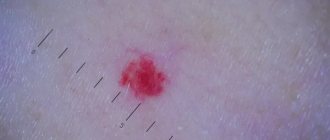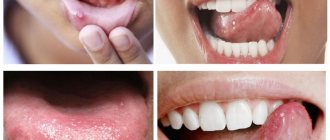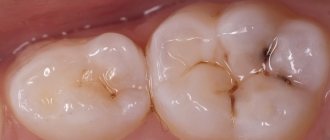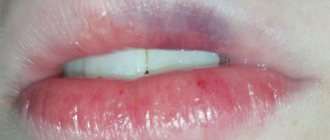G.B. Lyubomirsky
, dentist-therapist, periodontist, dental surgeon, candidate of medical sciences, assistant at the Department of Therapeutic Dentistry of the Federal State Budgetary Educational Institution of Higher Education IGMA of the Ministry of Health of the Russian Federation Head of the Dental Department of BUZ SE No. 1 of the Ministry of Health of the Republic of Uzbekistan
General Director of the ANO of additional professional education "Vladimir Center for Scientific and Practical Dentistry" (Vladimir)
Summary:
Analysis of literary sources showed that hemangiomas of soft tissues of the maxillofacial region, and, in particular, localized on the upper or lower lip, are an urgent problem in maxillofacial surgery, causing genuine interest among scientists and doctors regarding the etiopathogenesis and clinical and morphological features of the structure .
Our article presents the results of clinical studies on the symptoms of hemangioma localized on the lower lip. This clinical article shows the possibility of using a diode laser with a wavelength of 810 nm as an effective tool for performing surgery and presents the stages of this procedure. The results of our own research are compared with the corresponding data from literary sources. Key words:
mucosal hemangioma, lip hemangioma, diode laser, thermal ablation, lip aesthetics
Types of acquired red moles on the body
- Simple (capillary). Proliferation of newly formed capillaries, small venous and arterial vessels. Looks like a red spot.
- Cavernous. A spongy cavity with blood - a red or bluish nodule. Often forms under the skin.
- Branched (racellose). A plexus of tortuous dilated capillary trunks. They pulsate, noise and trembling are detected. It is rare and occurs on the extremities or face. If injured, life-threatening bleeding may occur.
How to identify hemangioma? Press on top of it and it should fade or disappear.
Features of the appearance of scars on the lip
Rough scar tissue can cause inconvenience and become not an imaginary problem, but a real one. The skin of human lips is very thin and sensitive. It is extremely easy to cause damage, let’s consider a number of possible causes of injury and scarring:
- Consequences of surgical sutures . In case of damage to the deep layers of the skin of the lips, it is impossible to do without suturing the edges of the wound. Also, this procedure cannot be avoided when removing tumors. Despite the professionalism of specialists, the damaged area of the lips will differ in color and texture, and serious scars may appear.
- Herpes . Unfortunately, 9 out of 10 people living on the planet are susceptible to this virus. Herpes does not disappear without a trace and becomes more active as soon as immunity decreases. On the skin, herpes appears in the form of rashes similar to pimples. They usually go away within a week, but if an infection occurs, the process may take longer. In place of the blisters, scars form that do not diminish for a long time.
- Scars due to piercings . For various reasons (allergy, failure to maintain sterility), the wound after a puncture with a needle can become inflamed. In this case, a noticeable scar will remain. But even if the procedure is successful, in most cases there is still an atrophic scar (a small depression at the piercing site). Such a scar is a natural reaction of the body to trauma.
- An animal bite on the thin surface of the lips. Yes, this happens quite rarely, but a kitten, having played too much, can accidentally injure its owner. Even very calm animals can do this. Along with the saliva of your pet, bacteria penetrate into the wound, which leads to complications. Lacerations after dog bites are also possible; in this case, stitches are required.
- Mechanical effect on the delicate skin of the lips. Even a minor injury that leaves a small bruise or wound can later develop into a pronounced scar.
- Tattoo . Today, the procedure remains fashionable and popular among women. This method of applying permanent makeup allows you to look good at any time of the day. The method involves introducing pigment under the skin in certain areas. Unfortunately, the market for cosmetic procedures is not well controlled. Low qualifications of tattoo artists lead to sad consequences for patients - too deep penetration of the needle or non-compliance with the procedure technology increases the chance of small scars appearing on the lips.
- Introduction of fillers . Beauty injections often lead to deformations of the face, especially the lips. They form fibrous tissue - subcutaneous scars, which can greatly distort the appearance of girls.
- Genetic diseases . Cleft palate or cleft lip (congenital or acquired cleft palate) - surgical interventions are required, scars are inevitable.
Classification of scars
In order to properly and successfully get rid of marks on the lips, it is important to understand what type of scar it is:
- Normotrophic - differs from the natural skin tone in a lighter color. Perfectly amenable to proper treatment and camouflage. The sensitivity of the dermis is preserved.
- Atrophic - heterogeneous and deepened when compared with a healthy area. Nerve endings and sensitivity are absent.
- Hypertrophic - a convex scar that rises above the skin level. Painted in a rich red color. The scar appears due to infection of a fresh wound and increased collagen production.
- Keloid - similar to hypertrophic, but unlike it, it grows beyond the wound, significantly exceeding its size.
Are red moles dangerous?
In themselves, these formations are harmless and are not precancers.
If you have a lot of red moles on your body, the cause may be a serious liver or pancreas disease. Pay attention to this - this is a reason for examination.
Problems may arise in case of traumatization of hemangiomas. Even fairly small formations threaten heavy bleeding, which is not easy to stop.
Clinical case
Patient L, 26 years old, presented with a traumatized mass in the axillary region. According to her, she tore off a convex hemnagioma with the edge of a rigid corset of a wedding dress almost a few minutes before the start of the wedding ceremony. The hemangioma bled very heavily and a large blood stain appeared on her white dress. She had to wear the witness's jacket over her wedding dress. It was in such a strange outfit that the wedding took place.
Introduction
An analysis of literary sources showed that in the structure of all human neoplasms, 29% are benign tumors and tumor-like formations of soft tissues of the face and neck. Among benign tumors of the soft tissues of the maxillofacial area, hemangiomas undoubtedly deserve special attention, which in 80% of cases are localized on the face and head.
In modern dentistry, there is a wide arsenal of surgical and conservative treatment methods for the treatment of hemangiomas. To remove hemangiomas, traditional surgical operations are used using a scalpel during surgery, cryodestruction, administration of sclerosing agents (70% alcohol, thrombovar, ethoxysklerol, fibrovein), diathermocoagulation, bucchitherapy (ultrasoft x-rays), close-focus radiotherapy, microwave hyperthermia, systemic and local administration of corticosteroid hormones and propranolol. A large number of the methods for removing hemangiomas proposed above have significant drawbacks in the form of risks of scarring complications and associated functional and cosmetic defects, which do not fully allow us to speak about the effective achievement of treatment results for this serious pathology.
Achievements and development of proprietary protocols in the field of laser dentistry have opened up new opportunities in the treatment of vascular anomalies. Modern diode lasers can generate light of a specific wavelength in a narrow part of the spectrum, which will correspond to the absorption line of a number of important chromophores (melanin, hemoglobin, water). In addition, modern dental diode lasers allow you to select the optimal radiation power and regulate the pulse duration.
Based on the study of the mechanisms of action of laser radiation on different types of biological tissue, depending on the wavelength, radiation power and pulse duration, we used the method of selective photothermolysis. The basis of this method is that by selecting the appropriate power and duration of the laser pulse, it is possible to achieve complete thermal damage to the tissue - the target subject to treatment, while minimizing thermal damage to the surrounding healthy tissue.
The introduction of a method of selective thermal ablation of pathological vascular formations localized on the red border of the lips, in our opinion, led to revolutionary changes in the treatment of this pathology.
How to remove a scar on the upper and lower lip
The healing time of the scar depends on the depth and size of the lesion, the presence or absence of inflammation and the state of the immune system. The scarring process is quite long, it can take up to 12 months. In difficult cases, the patient is recommended to resort to the following procedures:
- laser microdermabrasion is a resurfacing procedure that is carried out in several stages. The number of sessions depends on the area of the lesion;
- fractional photothermolysis - stimulation of fibroblasts (builder cells) with a carbon dioxide laser, which stimulates the production of healthy collagen. A course of 2–10 visits is required;
- coagulation - the scar is treated with a special laser to remove the excess number of small vessels. As a result, damaged skin is practically no different in color from healthy skin. The duration of the course is selected individually;
- drug injections - glucocorticoids (hormones) are often used to eliminate keloid and hypertrophic scars; they inhibit excess collagen. Due to this, the skin texture is evened out;
- Permanent makeup is not a method of treatment, but of disguising small scars. It is not suitable for everyone and is only relevant for minor injuries and cuts of the lips.
- photocorrection - the procedure stops the growth of connective tissue, stops the formation of sealing layers and seals blood vessels. The method is effective exclusively for fresh scars on the lip from herpes or filler removal.
Please note that these procedures are not suitable for everyone. In particular, getting rid of scars using laser and hormones has a number of contraindications:
- diabetes;
- lactation period;
- pregnancy;
- skin diseases;
- hormonal abnormalities;
- thyroid diseases.
In addition, you will have to stop taking a number of medications, staying in the sun, visiting a sauna or steam bath, and many other usual things.
In the case of contraindications for children, everything is much more complicated. Cosmetological and surgical manipulations with scars on the lips can only be prescribed by a doctor. This happens, as a rule, in cases where the child receives a fairly severe injury. But most often, hypoallergenic and gentle products are used that are well tolerated by children.
Traditional methods for treating a scar on the lip
Everyone can find handy products for home use. But traditional medicine recipes are not so effective due to their properties. They can only stimulate blood flow and relieve inflammation in the scar area. They can help with this:
- parsley juice;
- cocoa bean butter;
- honey;
- cinnamon.
You can make lotions from aloe leaves or eucalyptus juice, gruel from finely chopped onions or fresh celery. This will nourish the thin skin of your lips, but unfortunately, it will not prevent scar formation. The effect of such actions is insignificant and hardly noticeable.
In order not to resort to surgical intervention and not to use ineffective folk methods, experts recommend the anti-scar gel Fermenkol for the correction of scars.
A unique complex eliminates both fresh and old scars:
- returns the skin to its original appearance;
- increases the smoothness and elasticity of the skin;
- saves money and does not require expensive procedures;
- safe for children and pregnant women;
- does not contain hormonal components in its composition;
- acts on the problem locally, without affecting healthy tissue.











